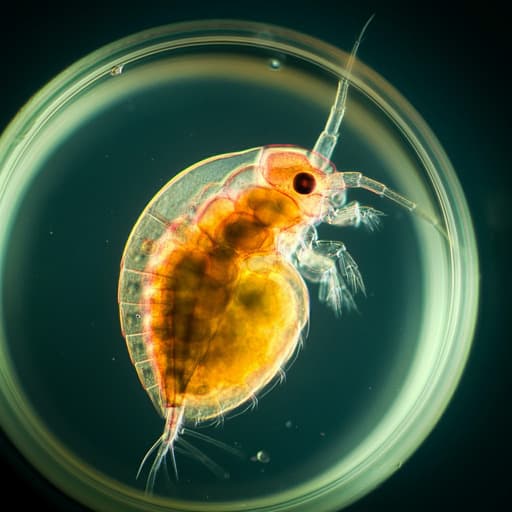
Biology
Zoobooth: A portable, open-source and affordable approach for repeated size measurements of live individual zooplankton
C. Broch and J. Heuschele
Discover the revolutionary Zoobooth: a low-stress, video-based method developed by Catharina Broch and Jan Heuschele for sizing individual zooplankton. This portable and affordable device achieves remarkable accuracy for Daphnia magna and other species, making it an essential tool for live mesozooplankton studies. Learn more about this innovative approach and how it can be adapted for various aquatic research needs!
~3 min • Beginner • English
Introduction
Body size is a key trait linking to metabolism, feeding, movement, sensory range, and ecological interactions in aquatic systems. In plankton ecology, size structure informs trophic structure and niche differentiation. However, obtaining accurate, repeated body size measurements on live individuals is challenging, especially for small, mobile organisms like mesozooplankton. Many existing tools (e.g., OPC, FlowCam, ZooScan) efficiently quantify communities but are not designed to repeatedly follow identifiable live individuals without immobilization or fixation, which precludes longitudinal studies and may induce stress. Traditional manual measurements under a microscope are precise but labor-intensive, require immobilization, and introduce observer subjectivity and handling stress. The authors sought a method to repeatedly measure individual Daphnia magna across lifespans with minimal handling risk and stress, suitable for portable use in culture rooms. They developed Zoobooth, a low-cost, open-source video-based approach coupled with automated analysis, and evaluated its performance for D. magna and other microcrustacean zooplankton.
Literature Review
Automated instruments such as the Optical Plankton Counter (OPC), FlowCam, and ZooScan efficiently provide abundance, size distributions, and taxonomic information for community-level studies, but they typically process fixed or pass-through samples and do not readily track individual live specimens across time. Manual slide-based measurements of immobilized zooplankton, including image-based methods supported by software (e.g., zooimage), are accurate but time-consuming and may stress organisms. Handling stress can affect growth and reproduction in fishes and potentially in Daphnia, though some studies found limited effects under certain conditions. Live-imaging approaches targeting behavior (Multi-DaphTrack; millifluidic chip systems) or population-level metrics (Daphniatox; live-population image analysis) are not optimized for repeated individual sizing. Other automated imaging systems (e.g., spheroid scanner-based well-plate methods, TRACKDEM in R) face limitations with 3D orientation and have reported lower correlations (R2 ≈ 0.68–0.80) between automated and manual size. These gaps motivate a method that minimizes handling risk, preserves experimental conditions, allows repeated measurements on known individuals, and achieves higher accuracy for non-spherical, freely swimming organisms.
Methodology
The Zoobooth workflow comprises three steps: (1) instrument setup, (2) imaging procedure, and (3) video analysis including selection of an optimal percentile estimator.
- Instrument setup: A Raspberry Pi (model 3 B+) with a Pi NoIR camera v2 fitted with a C-mount 6 mm adjustable-focus lens is mounted laterally to a 3D-printed housing accommodating a standard disposable cuvette (outer 1.2 × 1.2 × 4.5 cm). Two white LEDs illuminate frosted Plexiglas diffusers for even top-down lighting, while a dark rear compartment provides dark-field contrast. A 7-inch touchscreen provides a GUI to start recordings and enter sample identifiers; storage is via 1 TB external hard drive. Power is provided by power bank or mains. Total material cost ≈ 330 EUR; core components ≈ 130 EUR. Macro cuvettes (12 mm internal depth) were used for adult D. magna; half-micro cuvettes (4 mm) for juveniles and other taxa, limiting out-of-focus movement. Lens barrel distortion is corrected using an OpenCV calibration workflow (checkerboard filming; calibX.py), producing calibration matrices (dist.out, mtx.out, newcameramtx.out, roi.out) used during analysis.
- Imaging procedure: Individuals are gently pipetted from culture to the cuvette and inserted in the housing. A Python script (CameraScript.py; picamera v1.13) records h264 video at 1080×768 pixels for 30 s (modifiable) with ISO 200, sharpness 50, framerate 26, fixed exposure; other settings default. Live preview ensures the individual is in view and free-swimming for at least several seconds. Identifiers (treatment, age, individual ID) are set in script and baked into filenames. After recording, individuals are returned to culture. Each accepted video contains a moving animal in view for >3 s.
- Video analysis: A custom Python script (VideoAnalysisScript.py; OpenCV 3.0) processes videos frame-by-frame. Each frame is cropped to the cuvette interior, undistorted (cv2.undistort), converted to grayscale, and evaluated for sharpness (cv2.Laplacian). Background is subtracted (cv2.createBackgroundSubtractorKNN), followed by erosion (cv2.erode) to remove noise and delicate appendages, and dilation (cv2.dilate) to restore main body dimensions. Contours are detected (cv2.findContours); the largest object is evaluated against species-specific filters: area (MinArea–MaxArea), length:width ratio (MinLWratio–MaxLWratio), minimum brightness, minimum sharpness, and minimum distance from cuvette edge. If criteria are met, an ellipse is fit; major axis is recorded as length, minor axis as width (pixels converted to mm via a fixed calibration factor). The script outputs: (i) a detailed CSV (*.detailedsizedata.csv) with per-frame measurements and filenames; (ii) the first 19 analyzed frames saved as images to support manual validation; (iii) a summary CSV (*sizedata.csv) with a single per-video estimate based on an optimized percentile (see below) and the count of supporting frames. Processing a 30 s video takes ~11 s on a low-powered laptop.
- Optimal percentile selection: Because free 3D orientation skews per-frame length estimates (often underestimates), the authors determined, for each taxon, which percentile of the per-video length distribution best matches manual measurements. Using assessment datasets for D. magna (lab-cultured and long-term experiment frames) and field-sampled taxa, they computed percentiles from 50th to 100th for each video and chose the percentile minimizing the sum of absolute differences to manual lengths. For D. magna, the optimal percentile was ~93–94th; other taxa differed. These optimal values are stored in the script and used to generate the per-video size estimates.
Key Findings
- Daphnia magna accuracy: The optimal percentile for D. magna was determined at approximately the 93rd–94th percentile of the per-video distribution. The correlation between Zoobooth and manual measurements was strong (Pearson’s r ≈ 0.966–0.97; linear model R2 ≈ 0.93). Mean absolute differences: 0.10 mm (<2 mm individuals; mean size 1.27 mm), 0.18 mm (2–3 mm; mean 2.49 mm), 0.32 mm (>3 mm; mean 3.70 mm), corresponding to average relative percentage differences of 8.03%, 7.49%, and 8.62%, respectively. Newborns were slightly overestimated.
- Other taxa: Pooled across several field-collected microcrustaceans (Heterocope appendiculata; Eucyclops serrulatus & Mesocyclops leuckarti; Diaphanosoma brachyurum; Polyphemus pediculus; Scapholebrius mucronata), automated estimates agreed well with manual lengths overall (R2 ≈ 0.93). Species-wise performance varied: Diaphanosoma was underestimated consistently (ellipse fitting excluded the head due to differential transparency) but retained a linear relationship (R2 ≈ 0.83); cyclopoid copepods showed R2 ≈ 0.72; Polyphemus, Scapholebrius, and Heterocope had weaker relationships due to appendages and uneven transparency.
- Handling risk and feasibility: In a year-long Daphnia experiment (four clones at 15°C; average 26 recordings per animal), accidental mortality was low (7 of 320 individuals). Lifespans were comparable to or exceeded literature values, suggesting low handling stress (e.g., mean lifespans 74–133 days across clones).
- Practicality and cost: The complete setup is portable (~33×28 cm case; ~2.5 kg) and low-cost (~330 EUR total; core electronics ~130 EUR). Recording a video takes ~30 s; typical per-individual workflow ~1 min; analysis ~11 s per 30 s video on low-power hardware.
- Open-source and extensible: All design files, scripts, and calibration procedures are shared; species-specific filters and optimal percentiles can be added for new taxa.
Discussion
Zoobooth achieves the central goal of enabling repeated, minimally invasive size measurements on identifiable live zooplankton individuals. For D. magna, accuracy is high relative to manual microscopy, with strong linear relationships and manageable absolute and relative errors suitable for growth modeling and longitudinal studies. The method balances accuracy with efficiency, low cost, and portability, allowing measurements to be made without removing animals from their environmental conditions—reducing stress and hazards linked to immobilization or fixation. The percentile-based estimator effectively addresses the bias introduced by free 3D orientations, outperforming approaches that use median or mean frame-wise size. Compared with community-level instruments (OPC, FlowCam, ZooScan) or behavior-focused systems (Multi-DaphTrack, millifluidic chips) and other automated sizing pipelines (well-plate scanners, TRACKDEM), Zoobooth provides superior accuracy for individual live measurements and practical throughput for longitudinal designs. Performance varies by species morphology; taxa with pronounced appendages or non-uniform transparency may require customized image processing parameters, container geometry, or additional filtering. The approach’s open hardware/software design promotes adaptation for other taxa, traits (e.g., coloration), and educational use, and could be enhanced with machine learning for frame selection and species-specific detection.
Conclusion
The study introduces Zoobooth, a portable, open-source, and affordable imaging system and analysis pipeline for repeated size measurements of live zooplankton individuals. It combines a simple Raspberry Pi-based setup with OpenCV-driven object detection and a percentile-based estimator to correct for 3D orientation bias. For D. magna, Zoobooth closely matches manual measurements (r ≈ 0.97), with low absolute and relative errors, and shows promising performance across several other microcrustaceans. The system minimizes handling risk and stress, is time- and cost-efficient, and is readily modifiable. Future work could: (i) refine species-specific image processing and container geometries to handle appendages/uneven transparency; (ii) integrate machine learning for robust frame selection and species identification; (iii) expand to additional traits (e.g., coloration) and other plankton size classes; and (iv) standardize calibration across setups to ensure reproducibility.
Limitations
- Accuracy is lower than meticulous manual measurements; newborn Daphnia show slight overestimation.
- Performance depends on species morphology; taxa with prominent appendages or heterogeneous transparency can yield biased estimates unless processing parameters and possibly container design are adapted.
- Optimal percentile is setup- and species-specific; must be re-assessed after changes in optics, geometry, or camera settings.
- Requires assembly and some programming skills to build and customize; power supply limitations (e.g., power banks) can affect stability.
- Video analysis can occasionally fail to delineate outlines properly; erosion/dilation balance may truncate or include appendages.
- Depth of field and cuvette size constrain free-swimming orientation; suboptimal choices can reduce in-focus frames and accuracy.
Related Publications
Explore these studies to deepen your understanding of the subject.







